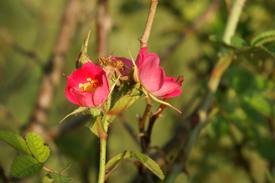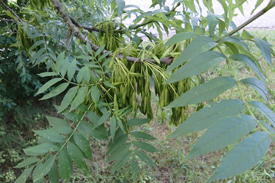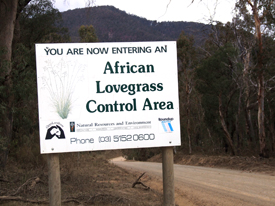Press release from July 13th, 2011
Chile is more dangerous for Argentina than vice versa
Researchers investigate the spread of invasive plant species in South America and Australia
Concepción/Halle (Saale)/Prague/Sydney • Invasive plant species in Chile pose a higher threat to its neighbour, Argentina, than vice versa. This was concluded by scientists from the University of Concepción in Chile and the Helmholtz Centre for Environmental Research (UFZ) after analysing the flora of both countries. In particular, 22 non-native species which occur in Chile on connecting roads leading to Argentina present a high risk according to the researchers, writing in the journal Biological Invasions.

Species like the sweet briar rose (Rosa rubiginosa) will be difficult to eradicate because they are now so widespread. 22 non-native species which occur in Chile on connecting roads leading to Argentina present a high risk according to the researchers.
Photo: Stefan Klotz/UFZ

Most of the invasive species arrived between 1840 and 1880 as well as between 1980 and the present, reflecting the waves of immigration. And around two thirds of them were deliberately introduced into Australia. They include many species used to decorate gardens such as the common ash (Fraxinus excelsior).
Photo: Stefan Klotz/UFZ

The African Love Grass (Eragrostis curvula) is a plant from Southern Africa. With contaminated grass seeds, it came to Australia. The authorities try to control the spread of the plant by preventing areas like here in the north of the State of Victoria, because the grass is monoculture, pushing back the native vegetation and increase in the dry summers of the danger of wildfires.
Photo: Tilo Arnhold/UFZ
Trade between Chile and Argentina mainly takes place by road. Over the past decade, the quantity of road freight between the two countries has more than tripled. Although the Andes once functioned as a natural barrier between both countries, the mountain range has been made increasingly porous by the increase in transport. Of the 875 alien species, nearly 300 occur only in Chile and the same quantity solely in Argentina while more than 300 are found in both countries. Invasive species can disturb ecosystems and cause severe damage to agriculture.
Researchers say the most dangerous species for the neighbouring country is yellow glandweed or yellow bartsia (Parentucellia viscosa), an annual herb native to the Mediterranean region which has already spread into 10 provinces of Chile within 48 years. “In our view, particular attention should be paid to shrubs and trees,” concludes Dra Nicol Fuentes. “Species like the elmleaf blackberry (Rubus ulmifolius), sweet briar rose (Rosa rubiginosa) and silver wattle (Acacia dealbata) will be difficult to eradicate because they are now so widespread. However, we’re still optimistic regarding the Portuguese broom (Cytisus striatus), which is only just starting to spread."
In the biologists’ view, it is important for scientists and other experts to set priorities for measures to counter invasive species. “Cooperation between neighbouring countries in the joint planning of countermeasures would be the most effective way of investing taxpayers’ money into the prevention and control of invasive plant species. This was shown by our investigation,” explains Dr Ingolf Kühn from UFZ.
Two years ago, the combined team of researchers from Chile and Germany evaluated the development of flora in Chile since 1900. Of the more than 70,000 samples in the herbarium at the University of Concepción, they identified 1,997 indigenous and 629 non-native plants. It turned out that within the space of a single century, invasive species had spread almost throughout the territory. The centre of this spread is the Mediterranean climate zone, where the Spanish colonial rulers began introducing farming from their European homeland in 1520. When Chilean agriculture and hence also grain production grew rapidly between 1910 in 1940, the invasive species spread swiftly.
In order to assess the risk resulting from certain species, the researchers used a method from Australia, where plant species from Europe are also a problem. Australian, Czech and German scientists demonstrated in a recently published study that 750 plant species from central Europe are now to be found in Australia. Most of the species arrived between 1840 and 1880 as well as between 1980 and the present, reflecting the waves of immigration. And around two thirds of them were deliberately introduced into Australia. They include many species used to decorate gardens such as the common ash (Fraxinus excelsior) and common beech (Fagus sylvatica). The first species thought to have arrived is the common hazel (Corylus avellana), which was first sold at Australian tree nurseries in 1803. In 1843 it was joined by the Norway maple (Acer platanoides), which was popular among landscape planners when laying out avenues. Given the presence of so many non-native species, researchers expect that others will take hold and spread invasively – albeit with some delay.
Publications
Fuentes, N., Ugarte, E., Kühn, I., Klotz, S. (2010): Alien plants in Southern South America. A framework for evaluation and
management of mutual risk of invasion between Chile and Argentina. Biological Invasions 12: 3227-3236.
http://dx.doi.org/10.1007/s10530-010-9716-9
This study was kindly funded by the EU in connection with the ALARM research project.
Phillips M. L., Murray B. R., Pyšek P., Pergl J., Jarošík V., Chytrý M. & Kühn I. (2010): Plant species of the Central European flora as aliens in Australia. - Preslia 82: 465-482.
http://www.ibot.cas.cz/preslia/P104Phillips.pdf
This study was kindly funded by the Australian Research Council and the Czech Republic.
Fuentes, N., Kühn, I., Ugarte, E., Klotz, S. (2008): Alien plants in Chile. Inferring invasion periods from herbarium records. Biological Invasions 10: 649-657.
http://dx.doi.org/10.1007/s10530-007-9159-0
This study was kindly funded by the EU in connection with the ALARM research project.
For more details, contact:
Dr Ingolf Kühn/ Dr Stefan Klotz
Helmholtz Centre for Environmental Research (UFZ)
Phone: +49-345-558-5311, -5302
Dr. Ingolf Kühn
Dr. Stefan Klotz
as well as
in Spanish and Englisch:
Dra Nicol E. Fuentes Parada & Prof. Eduardo Ugarte, PhD
Universidad de Concepción (Chile)
Phone: +56-41-2204418
Dr. Nicol E. Fuentes Parada
Prof. Eduardo Ugarte
in Englisch:
Prof. Petr Pyšek, Academy of Sciences of the Czech Republic, Průhonice / Praha
Phone: +42-271015266
Prof. Petr Pyšek
and
Megan Phillips & Dr Brad R. Murray, University of Technology Sydney
Telefon: +61-2-9514-4075
Megan Phillips
http://aconservationbiologist.blogspot.com/
Dr. Brad R. Murray
or
Tilo Arnhold
UFZ Press Office
presse@ufz.de
Phone: +49-341-235-1635
Other Links:
DAISIE database on non-native plants and animals in Europe:
www.europe-aliens.org
Development of an EU Strategy on Invasive Alien Species
ec.europa.eu/environment/nature/invasivealien/index_en.htm
Newsletter of the Asia-Pacific Forest Invasive Species Network (APFISN)
http://www.apfisn.net/
Biodiversity research in Germany is conducted at numerous institutions ranging from universities, non-university research institutes and departmental research to nature conservation organisations and the private sector. The Network Forum on Biodiversity Research, a project carried out by DIVERSITAS Germany, is designed to offer the research community a common overarching communication structure and culture. To find out more, visit:
www.biodiversity.de
At the Helmholtz Centre for Environmental Research (UFZ), scientists study the causes and repercussions of far-reaching environmental changes. They conduct research into water resources, biodiversity, the consequences of climate change and ways of adaptation, environmental engineering and biotechnology, bioenergy, how chemicals behave in the environment and their impact on human health, modelling, and aspects of the social sciences. The common theme of this diverse research is that it serves the sustainable use of natural resources and helps permanently protect these vital resources in the face of global change. At its sites in Leipzig, Halle and Magdeburg, UFZ currently employs about 1,000 people. It is financed by the German government as well as the governments of Saxony and Saxony-Anhalt.
The Helmholtz Association helps solve major, pressing challenges facing society, science and industry by means of first-rate research in six core fields: Energy, Earth and the Environment, Health, Key Technologies, the Structure of Matter, Transport and Space. With more than 30,000 employees at 17 research centres and an annual budget of some €3 billion, the Helmholtz Association is Germany’s biggest scientific organisation. Its work continues the heritage of scientist Hermann von Helmholtz (1821–94).
